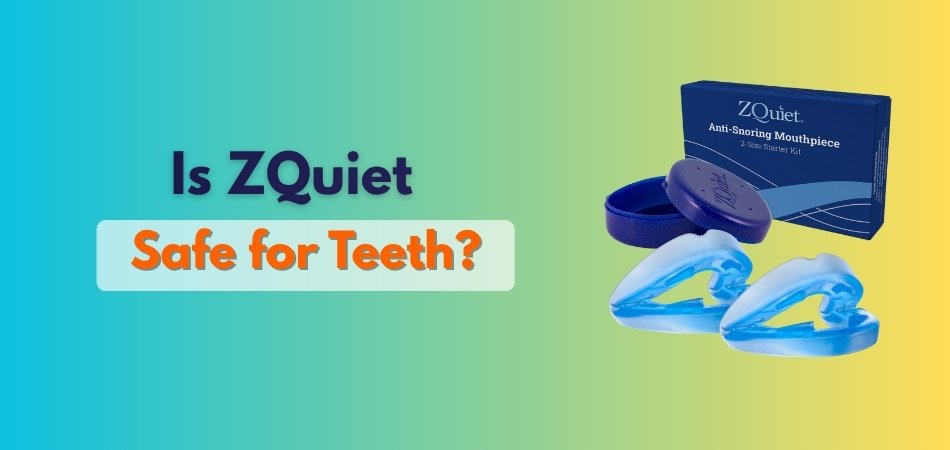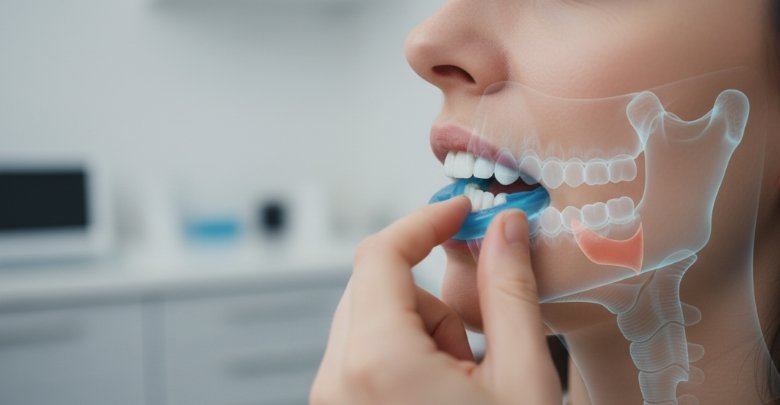Many people who struggle with snoring look for simple, non-invasive solutions that actually work. One popular choice is ZQuiet, a mouthpiece that helps improve breathing during sleep. Yet, before using it, most users ask a common question: Is ZQuiet safe for teeth, and can it be worn every night without worry?
Yes, ZQuiet is generally safe for teeth when used correctly. It’s made from BPA-free, medical-grade materials and designed to rest gently in your mouth without changing your bite. Most users report comfort after a short adjustment period, experiencing relief from snoring without dental discomfort.
If you’re thinking about trying ZQuiet but want to understand how it affects your teeth, gums, and jaw alignment, keep reading. This article explains everything you need to know about its safety, proper use, and dentist-approved practices for long-term comfort.
Is ZQuiet Safe for Teeth?
Many people wonder if using ZQuiet, a popular anti-snoring mouthpiece, can affect their teeth or gums. The short answer is yes, ZQuiet is generally safe for teeth when used correctly and fitted properly. According to the majority of ZQuiet review experiences, most users find it safe, flexible, and comfortable for nightly use. Here’s why ZQuiet is considered safe for your teeth:

Made From BPA-free, Medical-grade Material
ZQuiet is made from high-quality, BPA-free medical-grade material that is safe for prolonged oral contact. This ensures there’s no chemical irritation, allergic reaction, or enamel damage. The material’s soft texture helps it stay gentle on gums and teeth while maintaining strength and shape even after repeated use over time.
Designed to Gently Adjust Jaw Position
ZQuiet works by slightly moving your lower jaw forward to improve airflow and reduce snoring. This subtle movement does not alter your bite or permanently shift teeth. Instead, it allows natural jaw flexibility, helping you sleep comfortably while keeping your teeth properly aligned and free from unnecessary pressure or discomfort.
FDA-Cleared for Oral Use
ZQuiet is FDA-cleared as a Class II medical device, meaning it has passed strict safety and quality checks. This certification confirms that the product is safe for oral use and effective for snoring relief. It also ensures that every unit meets health standards designed to protect your teeth and gums.
Soft-Flex Design Reduces Tooth Strain
Unlike rigid mouthpieces, ZQuiet features a patented soft-flex hinge design that moves naturally with your jaw while you sleep. This flexibility prevents excessive strain on your teeth and reduces jaw tension. The smooth, adaptive movement also helps users experience comfort without feeling restricted, even during long hours of wear.
Comfortable Fitting Reduces Pressure
Each ZQuiet mouthpiece is pre-molded to fit most users’ mouths comfortably without requiring boiling or molding. This even distribution of pressure prevents stress on individual teeth or sensitive gums. The gentle fit also helps maintain a natural bite alignment, reducing the risk of soreness or long-term dental discomfort after consistent use.
Overall, ZQuiet is considered safe for teeth when used as directed and properly maintained. However, like any oral device, comfort and results may vary between users. If discomfort persists or if you have pre-existing dental concerns, consulting your dentist is the best step before long-term use.
Can ZQuiet Cause Any Discomfort or Tooth Issues?
Some users may feel slight discomfort when first using ZQuiet, as their mouth and jaw adjust to the new position during sleep. This initial sensation is common and temporary. ZQuiet is designed to adapt naturally to the user’s mouth over time, helping most people experience comfort after a few nights of consistent use. As your body adjusts, you may notice a few mild effects worth understanding:
Jaw Stiffness During the First Few Nights
Some users report mild jaw stiffness when they start wearing ZQuiet. This happens because the lower jaw is held slightly forward to keep the airways open. The stiffness usually lessens after a few nights as muscles adapt. Gentle jaw stretches in the morning can help ease this temporary feeling.
Gum or Tooth Pressure
When wearing ZQuiet, users might initially sense gentle pressure on the gums or teeth. This is a normal adjustment response as the mouthpiece finds its natural position. The sensation fades as your mouth becomes familiar with the fit. If it persists, ensuring proper alignment often helps restore comfort quickly.
Mild Tooth Sensitivity
A few people experience slight tooth sensitivity at the beginning. This occurs when the device contacts the teeth more closely than usual. Maintaining good oral hygiene and wearing the device for shorter periods at first can minimize the feeling. Most users find it completely subsides after regular, correct use.
Effects of Improper Fitting or Overuse
Improper fitting or extended use can lead to added strain on the jaw or specific teeth. It is important to follow the fitting instructions carefully to avoid uneven pressure. Overuse without rest can also cause discomfort, which is why gradual adaptation is key to long-term comfort and safety.
Mild discomfort from ZQuiet is typically short-lived and not harmful to your dental health. Most users find that their mouth quickly adjusts within a few nights of proper use. If discomfort continues or worsens, consulting a dentist can ensure the best fit and experience for your needs.
How ZQuiet Affects Your Teeth and Jaw Alignment?
ZQuiet works by slightly repositioning your lower jaw to help keep your airway open while you sleep. This gentle adjustment improves airflow and reduces snoring without putting too much strain on your teeth or gums. The movement is subtle and designed to maintain a natural, relaxed bite throughout the night. Here’s how ZQuiet affects your teeth and jaw alignment in practical terms:

Gentle Forward Movement of the Lower Jaw
ZQuiet moves the lower jaw a few millimeters forward to prevent airway collapse during sleep. This small repositioning is just enough to allow better breathing while resting. It does not force your teeth into a new position or alter your bite permanently, making it suitable for nightly use.
Temporary Adjustment Without Lasting Changes
The movement of the jaw when wearing ZQuiet is temporary and ends once you remove the device. Your teeth and jaw naturally return to their usual position after use. This is why users can safely wear ZQuiet nightly without worrying about long-term alignment issues or unwanted dental shifts.
Muscle Adaptation Occurs Over Time
When you start using ZQuiet, the muscles around your jaw and mouth adapt gradually to the new position. This natural adjustment process helps the device feel more comfortable with regular use. Over time, the muscles become accustomed to the gentle forward posture, maintaining relaxation and support for the jaw.
Dentist-Approved Fit Maintains Comfort and Balance
ZQuiet’s design is based on dentist-approved principles to maintain a balance between effectiveness and comfort. Its flexible hinge allows the mouthpiece to move naturally with your jaw while you sleep. This prevents stiffness and helps keep the bite aligned, ensuring both comfort and dental stability during repeated use.
Certain Users Should Avoid Using ZQuiet
Although ZQuiet is generally safe, there are some not recommended users of ZQuiet, such as individuals with loose teeth, gum infections, jaw pain, or temporomandibular joint (TMJ) disorders. These users should consult their dentist before wearing the device to avoid strain or worsening of existing oral health conditions.
ZQuiet’s design supports the jaw in a way that promotes better breathing without disturbing tooth alignment. With proper guidance and dental awareness, most users can experience restful sleep and long-term comfort. However, anyone with pre-existing jaw or gum conditions should seek professional advice before regular use.
Tips to Use ZQuiet Without Harming Your Teeth
Using ZQuiet correctly can make a big difference in comfort and dental safety. When worn properly, it supports your jaw alignment and helps prevent unwanted strain on your teeth. The key is to follow simple habits that keep your mouthpiece clean, well-fitted, and gentle on your dental structure.
Here are some practical tips to help you use ZQuiet safely and effectively:
- Check the Fit Before Sleeping: Always ensure that your ZQuiet fits snugly but comfortably before going to bed. A proper fit helps maintain even pressure across your teeth. Following the correct method on how to wear ZQuiet ensures it sits naturally and avoids unnecessary tension.
- Avoid Jaw Clenching While Wearing It: Try to relax your jaw muscles once ZQuiet is in place. Clenching or grinding can increase strain and reduce comfort. A relaxed jaw helps the device stay balanced, protecting your teeth from unwanted pressure during sleep.
- Adjust If the Fit Feels Too Tight: If ZQuiet feels tight or uncomfortable, avoid forcing it into position. Slight repositioning or short usage periods can help your mouth adjust gradually. For persistent tightness, it’s best to check your fitting or consult your dentist for guidance.
- Store the Device in Its Case: Always store your ZQuiet in its protective case when not in use. This prevents damage, keeps it clean, and helps maintain its original shape. A clean, secure case also protects it from bacteria and dust exposure.
- Replace It When You Notice Signs of Wear: Over time, your ZQuiet may show minor wear or reduced flexibility. Replace it when the material feels softer or starts to lose its shape. Timely replacement ensures the best comfort, hygiene, and effectiveness during use.
Regular cleaning and proper fitting help prevent irritation and extend the life of your mouthpiece. By treating ZQuiet with care and maintaining consistent oral hygiene, you can enjoy comfortable, worry-free sleep without harming your teeth or jaw.
When to Stop Using ZQuiet and Visit Your Dentist?
While ZQuiet is safe and comfortable for most users, some individuals may experience discomfort that signals the need for a dental checkup. Paying attention to these signs helps prevent potential oral issues and ensures long-term comfort. Here are the main signs that indicate it’s time to visit your dentist:
Continuous Jaw Pain After Several Nights
If you experience jaw pain that continues for more than a few nights, it could mean your mouthpiece isn’t fitting correctly. Prolonged strain on the jaw muscles can cause soreness or stiffness. Taking a short break from use and consulting your dentist can help resolve the issue before it worsens.
Persistent Tooth Sensitivity
A temporary sense of tooth pressure is normal during the first few nights, but ongoing sensitivity might point to misalignment. When teeth feel sore even after removing ZQuiet, it’s best to stop using it. A dentist can check the bite balance and make necessary adjustments for comfort.
Gum Swelling or Redness
Swelling, redness, or gum tenderness can be a sign that the mouthpiece is applying uneven pressure or trapping bacteria. Proper cleaning may help, but if irritation continues, professional evaluation is needed. Your dentist can identify whether the fit or hygiene routine requires correction.
Difficulty Closing the Mouth Naturally
If you find it hard to close your mouth comfortably after removing ZQuiet, your jaw alignment might be under strain. Continuing to wear the device in such cases may worsen the issue. Stopping use and getting a professional fitting ensures better jaw positioning and protection for your teeth.
It’s always better to be cautious when using any oral device. If discomfort or pain persists, pause ZQuiet use and visit your dentist. A professional can assess your bite, adjust the fit, or recommend alternate solutions to help you sleep comfortably and safely.
How to Maintain Oral Hygiene While Using ZQuiet?
Good oral hygiene is an important part of getting the best results from your ZQuiet device. Cleaning it regularly prevents bacteria from building up and protects your teeth and gums from irritation. A clean mouthpiece also feels fresher, lasts longer, and keeps your nightly routine safe and comfortable. Here’s how you can maintain oral hygiene while using ZQuiet effectively:

Clean ZQuiet After Every Use
Wash your ZQuiet using mild soap and warm water after each night’s use. This step removes bacteria and saliva that collect during sleep. Avoid using hot water, as it can change the shape of the material and affect how the mouthpiece fits your teeth.
Brush and Floss Before Wearing
Brush and floss your teeth before wearing the device each night. Doing so helps prevent trapped food particles and bacteria from staying under the mouthpiece. This simple step reduces the risk of gum irritation, bad breath, and plaque buildup during long hours of use.
Store in a Clean and Dry Case
Once cleaned, make sure your ZQuiet is completely dry before placing it in its protective case. A dry environment prevents mold growth and odor. Keeping it in a dedicated storage box also protects it from dust, bacteria, and accidental damage between uses.
Replace ZQuiet When Needed
ZQuiet’s materials naturally soften or wear down over time. Replace the device every few months or when it shows visible signs of wear. Using a fresh mouthpiece ensures proper fit, hygiene, and comfort so your snoring solution continues working as intended.
Regular Cleaning Helps Prevent Irritation
Regular cleaning and correct fitting are essential to maintaining gum comfort and oral health. Consistent care helps prevent soreness, discoloration, or bacterial buildup. Establishing this routine ensures that your device remains both effective and safe for daily use.
Maintaining both your ZQuiet and your oral hygiene ensures comfort and long-term dental health. When you clean, store, and replace your mouthpiece regularly, you protect your teeth and enjoy peaceful, worry-free sleep every night.
Frequently Asked Questions
After learning about how ZQuiet works and its safety for your teeth, you might still have a few questions in mind. Here are some common ones that many users ask before or after starting to use ZQuiet for snoring relief.
How Long Does It Take to Get Used to ZQuiet?
Most people adjust to ZQuiet within a few nights of regular use. The initial jaw or gum pressure usually fades quickly as your mouth gets used to the fit. Starting with shorter wearing times can help make the transition smoother.
Can I Wear ZQuiet If I Have Dental Work Done?
Yes, but it depends on your dental condition. People with crowns, bridges, or veneers should consult their dentist first. A professional can check if ZQuiet will fit properly without disturbing your dental restorations or causing any discomfort during use.
How Should I Clean ZQuiet Properly?
You can clean your ZQuiet using mild soap and warm water after every use. Gently brush the surface with a soft toothbrush if needed. Avoid harsh chemicals or hot water to prevent damaging the material or changing its shape.
Can I Use ZQuiet Every Night?
Yes, ZQuiet is designed for nightly use. Many users wear it consistently without any issues. Regular cleaning and proper storage are key to keeping it safe and comfortable for long-term use. Replace it when you notice visible wear or reduced flexibility.
Is ZQuiet Comfortable to Wear All Night?
ZQuiet is made with a flexible hinge that moves with your jaw naturally. While it might feel unusual at first, most users find it very comfortable after a few nights. The lightweight, soft material helps prevent jaw strain during sleep.
Can ZQuiet Be Used for Heavy Snoring?
Yes, ZQuiet can help reduce heavy snoring by improving airflow through gentle jaw repositioning. However, if your snoring is linked to severe sleep apnea or medical conditions, it’s best to consult a healthcare professional before relying solely on the device.
How Often Should I Replace My ZQuiet Mouthpiece?
It’s best to replace ZQuiet every few months or when it starts feeling loose or worn. Regular replacement keeps the fit secure and ensures hygiene. Following the manufacturer’s timeline helps you maintain the best comfort and snoring control.
Concluding Lines
Many users find ZQuiet both safe and effective when used correctly. It provides a simple solution for better sleep without putting unnecessary strain on your teeth or gums. Regular cleaning and proper fitting can make the experience even more comfortable.
To answer the main question, is ZQuiet safe for teeth? The answer is yes for most users. Its flexible, dentist-approved design ensures that your jaw remains relaxed and your teeth stay protected throughout the night. Those with dental issues should still consult their dentist before starting use.
Overall, ZQuiet can be a helpful and safe way to manage snoring. By following simple hygiene and usage steps, you can enjoy peaceful nights while keeping your dental health in good shape.






